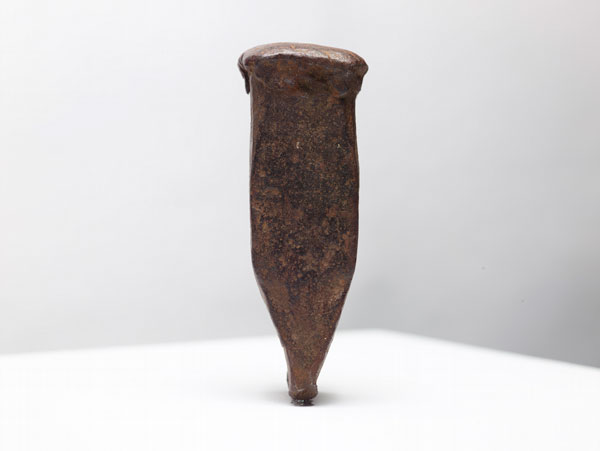Known for her minimal interventions in public spaces, creating subtle shifts in environments, either visually or with sound, New Orleans-based Zarouhie Abdalian has garnered significant acclaim. With four components considering the concept of work, “To History” elicits an overall impression of remembrance and remorse.
Entering the first gallery, one is immediately drawn by the distant sound of banging and tapping that echoes throughout the largely vacant space. Dotted around the expansive gallery, small wall-mounted Hydrocal casts titled from chalk mine hollow were pulled from molds made of the walls of the Mississippi Chalk Hollow mine, closed since 1912. (The abandoned mine itself is now a minor tourist attraction.) Each cast bears rough marks denoting where chalk was hacked out from the earth. From chalk mine hollow (iv) (all works 2017) houses a vertical trough with a smooth curved edge spanning the length of the slab. The rest is rough and irregular, with peaks, craters and pits, and the faintest traces of pastel pigment.
Six pedestals form regular rows dividing the gallery, each around chest height. Each bears a single metal object, a tool, or head of a tool, brunt (i-vi), encased in a thick coat of rust. The “sharp” edges, each poised on the top of the pedestal, actually appear blunt, having been eroded by time and use. Perhaps they symbolize the human workers who also bore the brunt of their labor; as one considers these objects as stones and monuments, a somber air arises.

Zarouhie Abdalian, from chalk mine hollow (iv), 2017, courtesy of the artist and Altman Siegel, San Francisco.
The second gallery features an installation of five hanging cotton panels, to history (i-v), and brunt (vii) on a pedestal. Created by a frottage process, with delicate red pencil rubbings made from a six ton wrecking ball, the panels are lyrical, swaying slightly in a small breeze.
The source of the sounds is ultimately revealed in a third gallery, a quartet of speakers mounted high on the wall and a large black subwoofer on the floor, playing threnody for the millions killed by silicosis, a collaborative work with Joseph Rosenzweig. At full volume it’s deafening, with the base reverberating at an alarming, seemingly cardiac arrest-inducing level. Silicosis is, one may note, a disease endemic to miners who inhale particulate matter. Sounds are of knapping, the process of making stone tools by striking with rocks, digitally mixed to reproduce the effect of echoing within different specific acoustic environments, such as a mine or a dungeon.
The history of mining, like that of civilization itself, is scarred with many acts of abuse and domination. Miners have become an emblem of a certain kind of noble suffering. Still, the feeling of work, in particular of the hardships endured by human beings engaged in such a treacherous activity as mining, seems oddly missing from the equation here, which is all pristine objects and elegant presentation. Yet, as a memorial to lives lost in the name of commerce, there is a quiet dignity to the mute objects—disturbingly juxtaposed with the clamoring soundtrack.


